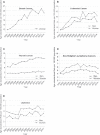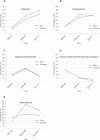Temporal trends in the incidence and demographics of cancers, communicable diseases, and non-communicable diseases in Saudi Arabia over the last decade
- PMID: 30834424
- PMCID: PMC6468216
- DOI: 10.15537/smj.2019.3.23585
Temporal trends in the incidence and demographics of cancers, communicable diseases, and non-communicable diseases in Saudi Arabia over the last decade
Abstract
To describe the trends in the incidence rates of 5 most common cancers, communicable diseases, and non-communicable diseases in Saudi Arabia over the last decade. Methods: The incidence rates of cancers (2001-2014), communicable diseases (2003-2016), and non-communicable diseases (1990-2017) were retrieved, classified, and analyzed retrospectively during November 2017, based on data available with the Ministry of Health and were analyzed at the Imam Abdulrahman Bin Faisal University in Dammam, Kingdom of Saudi Arabia. Results: Age-standardized incidence rate (ASR) (per 100,000 population) of breast cancer among women increased dramatically from 11.8 in 2001 to 22.7 in 2014, indicating a 92.4% increase over the decade. Colorectal cancer incidence was the highest among men, and its ASR per 100,000 population increased from 5.0 to 10.6 in men and from 5.0 to 8.2 in women. Among communicable diseases, incidences of hepatitis B, measles, chickenpox, and brucellosis decreased while dengue fever increased. An alarming increase was observed in the incidence rate of non-communicable diseases namely, obesity, diabetes, and hypertension. Conclusion: The incidence rate of non-communicable diseases increased over the decade and was associated with increased mortality and disability, reduced quality of life, and increased health-care costs, indicating an urgent need to establish prevention and control programs. The rising trend in the incidence of cancers may also become a health care issue in Saudi Arabia in the coming years.
Figures




References
-
- World Health Organization 2015. Health profile of Saudi Arabia. Available from: http://apps.who.int/iris/handle/10665/253771 .
-
- World Health Organization 2006. Regional office for Eastern Mediterranean Cairo Egypt. Country Cooperation Strategy for Saudi Arabia 2006-2011. Available from: http://www.who.int / countryfocus / cooperation_strategy / ccs_sau_en.pd... .
MeSH terms
LinkOut - more resources
Full Text Sources
Medical

